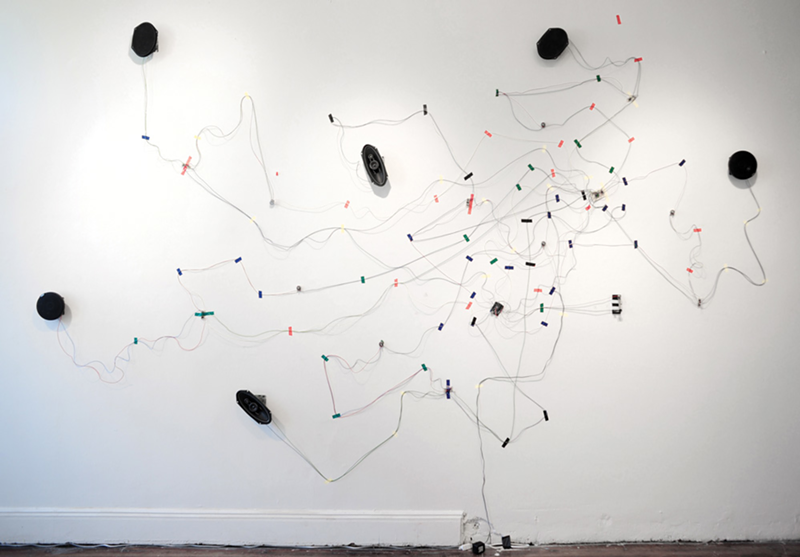The 20th century looms large in Paul Schuette’s new show Compositions at semantics. An investigation into form, structure and sound, the exhibition’s multimedia works orient themselves around Modernism’s concern with quintessence, but pose typically Postmodern questions about how we define genres and the context in which we encounter works of art.
A Ph.D. candidate at University of Cincinnati’s College-Conservatory of Music, Schuette is interested in what he calls the “fragile and unstable” aspects of contemporary art-making, and this interest takes the form of several pieces that are part sculpture and part electronic instrument, steadfastly refusing to be either one or the other.
The works are awkward, almost clumsy constructions that are technically refined but formally graceless. Rather than being repellant, their inelegance is an endearing quality. The electrical tape, exposed wires and ponderous black insulating rubber frequently visible in Schuette’s pieces look honest and handmade, a potent antidote to the lobotomized design that plagues contemporary audio devices.
“Circuit Drawing” is a wall-mounted assortment of speakers linked by a tangle of multi-colored wires, randomly placed potentiometers, an Arduino board and a device that resembles a Morse code key. Tap the key’s trigger and the speakers erupt in a cacophony of electronic squeals, bleeps and shouts that can be altered on the fly by adjusting the “pots” scattered across the surface.
The work looks as chaotic as it sounds, meandering across the breadth of the wall seemingly without reason. Its lines describe nothing but its own dimensions. “Circuit Drawing” is not beautiful to behold, but it probes at the nature of drawing and sculpture by pushing distinctions between the two to the limit.
Operating it, on the other hand, is pure joy. The aural blasts out of “Circuit Drawing” can be controlled (to a point), transforming the viewer into a composer. Both works confront the traditional roles assigned to the audience, blurring distinctions between viewer, participant and creator.
But perhaps the most thrilling work is the one that bends the parameters of genre and medium the least.
An original composition for string quartet, “…no news is good news” is five movements based around five consecutive issues of The New York Times (April 25-30, 2005). The framed front page of each edition stands before the viewer and features a series of words circled seemingly at random and connected across the page by Schuette’s graphic score, resulting in a“stellar constellation” of words.
Accessed by a series of headphones, “…no news” is the most “musical” element in the show. The work abounds with improvised sound of screeching violin glissandi, groaning cello and pizzicato hits coupled with voices shouting out the newspaper’s circled words. The forced rhyming of “Iraq, attack,” and “tax” have a particularly percussive and political texture. A fan of George Antheil’s eccentric compositions, I savored them.
But for the amount of space given over to improvisation, the movements are oddly congruent. Most reach a sort of climax around the three-minute mark, and because Schuette is breaking down structure and composition there is little to distinguish one from the other, except for Tuesday, April 26.
Like a traditional second movement, it’s slow and subdued. The lazy horizontal structure of “Tuesday” is harmonically distinct, dialing back the assertiveness of the other sections and drifting across the spectrum in hushed tones. It demands repeated listening.
In his statement Schuette wonders how his musical works will “navigate the terrain” of an art gallery now that “music is no longer confined to the concert hall and art no longer needs a gallery.” The answer is — just fine.
I’m not convinced that either visual art or musical performances have been confined to specific venues for decades, if ever. Transistor radios, the Sony Walkman, and now the ubiquitous iProducts have utterly erased the connection between sound and context. Electronically reproduced music is literally everywhere at all times, and Schuette’s pieces aren’t fundamentally altered by this cultural development.
The same holds true for visual art. The “white wall” gallery is a comparatively new phenomenon born of Modernism’s (regrettable) capacity for bureaucratizing the senses and the experience of different art-forms. In the case of Compositions, Schuette stages something of a restoration, challenging recent historical developments by creating works of art that address multiple senses simultaneously and thoughtfully, no matter the context.
Paul Schuette’s
COMPOSITIONS continues at semantics through May 26.


